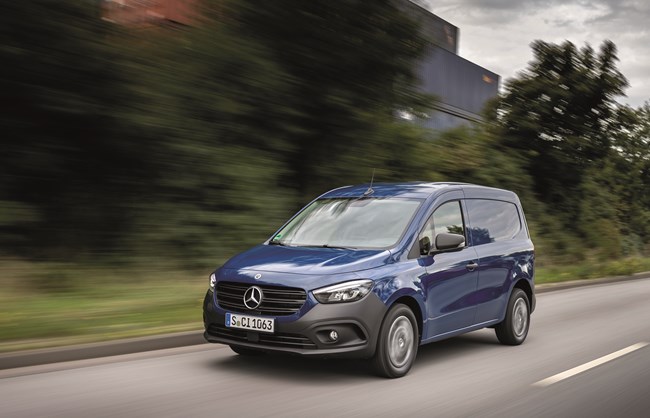- ETRUX launches new Ford E-Transit Trizone
- Renault gives UK debut to Master E-Tech at CV Show
- Isuzu D-Max long-term test – Latest Report
- Isuzu D-Max V-Cross Steel Edition revealed
- IVOTY Report: Stellantis explores the hydrogen proposition
- New Maxus EVs include eDeliver 5 van
- Used LCV values reach six-month high
- ADVERTISEMENT FEATURE: IVECO Daily Mission Awards 2024 Q2 Round-up: Grounds Maintenance & Forestry
- Stellantis Pro One electric vans review
- Mitie adds 5,000th EV to fleet
IVOTY Analysis: What's in a name?
Date: Friday, November 12, 2021 | Author: George Barrow
If the first Mercedes Citan was essentially a Renault Kangoo with a desirable badge, what’s changed with the second generation?

Hey Mercedes, what’s the difference between the new Mercedes-Benz Citan and the Renault Kangoo?” That’s the question I asked the brand-new Mercedes Citan but it’s also a question I asked the Mercedes engineers and executives several times with varying responses, which ranged from the feeling of it being a Mercedes, to its safety and of course the design.
That’s because, where the first generation Citan was a rebadged Kangoo with a token number of changes made to justify the Mercedes price tag attached to it, this new Citan has been a more collaborative effort between France and Germany.
First impressions are that the Citan is more tuned in to the Mercedes family than ever before with not only its three-bar grille and narrow headlights that incorporate LED daytime running lights, but also with its interior that makes use of the Mercedes parts bin to include the MBUX (Mercedes-Benz User Experience) infotainment system in the Citan.
It’s why I’m able to ask it naturally phrased questions using the voice command “Hey Mercedes” just like you can in the Sprinter and any number of Mercedes cars. On the inside, the Citan does now feel significantly more like a Merc than before. The interior is a mix of the passenger car and commercial vehicle range with a leather-trimmed multifunction steering wheel to control both the digital screen in the instrument cluster and the 5in MBUX screen in the centre of the dash.
Upping the quality levels in the interior are some chrome trims around the air vents and also on the heating control dials, along with piano black fascia elements across the dash – most noticeably around the screen and vents. It’s intelligent repackaging of the Kangoo interior, which was so ably demonstrated in the X-Class pick-up truck, which worked hard to hide and disguise its Nissan Navara components. In a similar manner, the most obvious parts of the Citan are all Mercedes with just a handful of items like the internal door handles and handbrake appearing to be shared items, but beneath the skin the story is very different.
Mercedes paints a convincing story of a van that has been built and indeed improved to meet the expectations of its customers – not least in the aspect of safety systems, which Mercedes says were tested and fine-tuned at their test facility in Immendingen. The result should be a vehicle capable of a better Euro NCAP score than its predecessor, which was originally awarded just three stars. This time around the Mercedes will hope for a better result as both Sprinter and Vito are well known for their high safety standards. As a result, Citan gets hill start assistance, Attention Assist and Crosswind Assist as well as six airbags as standard.
Other optional systems include Active Lane Keeping Assist, Blind Spot Assist and Speed Limit Assist with traffic sign detection along with adaptive cruise control, all of which will likely feature on the top spec UK versions of the Citan.
The push for better safety standards, as well as differentiating itself with the design are amongst the key principles Mercedes has aimed for in the new Citan along with improved connectivity through the integration of MBUX and its own ride comfort and driving characteristics.
As with the previous generation Citan, Mercedes has adjusted the suspension and dampeners to create different driving characteristics to the Renault Kangoo version but all other mechanical elements are shared and it’s perhaps quite telling that detail on the engines is relegated to page 22 of the van’s information, well behind the design, equipment, connectivity, safety and testing procedures of the new van.

Power comes from a shared Renault engine, with three diesel options and two petrol versions. The diesel range is made up of engines with nominal ratings of 75hp, 95hp and 116hp, while petrol vans get 102hp and 131hp options. UK specification has yet to be decided ahead of the van’s launch in Spring 2022. This too is when an electric eCitan van with a 75kW motor with 44kWh battery pack giving it a claimed range of 177 miles will also be available. Transmission options for the diesel will include a seven-speed dual-clutch auto as well as the standard six-speed manual. As well as the panel van, which will be available in short and long-wheelbase lengths, there will also be a five-seat combi van and a more passenger focused Tourer model. This is on top of the premium T-Class variant that will sit within the passenger car range and likely include an eCitan-based EQT all-electric model.
Having driven a combination of panel van and Tourer with manual and automatic gearboxes, the good news is that the Citan is a considerable improvement over the old model and is overall an accomplished small van. Just like the Kangoo, the Citan is quiet, comfortable and engaging to drive.
Whether the fine-tuning claimed by the Germans has made much of a difference will require some back-to-back testing but first impressions are that the Citan feels a little firmer and therefore sportier in the steering but harsher in the ride. It’s fine margins, though and a variable that will depend largely on whether your van is crammed full, at half payload or near empty. But, the usability of the van has improved too thanks to a widening and lengthening of the van’s overall dimensions.
Regular vans now have a 2.9m3 loadspace capacity (which by virtue of the German VDA way of measuring space using small blocks is different to the Renault’s 3.3m3 claim, despite it being the exact same rear end) and get a folding bulkhead with collapsing passenger seat to give you up to 3.05m for long items. Maximum payload is up to 782kg for a Citan with a gross vehicle weight of 2.25t, and models will have a 1.5t towing rating.
One very obvious difference between the Kangoo and Citan, however, is that the Kangoo has a unique loadspace trick up its sleeve – it’s called the Open Sesame door – but as it won’t be available in the UK it seems remiss to even mention it.
It’s also important to note that final UK specification for both the Renault and Mercedes have not been decided upon yet, so while the stories from both sides of the creative discussion paint a picture of co-operation between Paris and Stuttgart the final reckoning will certainly be in the product that arrives on these shores.
In the case of both models, though, the improvements are large, significant and a genuine threat to the small van hegemony that the Ford Transit Custom, Volkswagen Caddy and to some extent the Vauxhall Combo and its French siblings have enjoyed. There’s no doubting that Citan is a huge step forward, but there’s still the question I raised at the beginning that needs a solid answer.
What are the differences between the Kangoo and the Citan? Well, in the van’s own words: “That question is too hard for me”. And after thinking about it over the course of writing this article, I have decided that I’m very much inclined to agree.
IVOTY contenders in the starting blocks
Previously I told you about the contenders for the International Pick-Up Award with the Toyota Hilux, Jeep Gladiator and Isuzu D-Max all up for contention, but 17 November will also be the day when I can exclusively reveal the winner of the International Van of the Year 2022 and what a contest it promises to be.
There are 10 vans in the running whittled down from a longer list of 16, with the Fiat Ducato, Renault Express, Renault Kangoo, Mercedes-Benz Citan, Peugeot e-Partner, Citroen e-Berlingo, Vauxhall Combo-e, Toyota Proace City Electric, Toyota Proace Electric and Volkswagen Caddy 5 all eligible for the award. It’s going to be a close contest too. As you’ll read on these pages and elsewhere, the Renault Kangoo and Mercedes-Benz Citan double act are a huge improvement and the quartet of Stellantis-made vans are amongst the best electric vans on the market.
While the VW Caddy is a great van packed with new tech my dark horse is the Fiat Ducato. You’ll hear more about it from me soon, but despite being another shared model with Stellantis, it has really moved the game on and I admire Fiat’s independent thinking. I can’t wait to see how my IVOTY jury peers all vote.
George Barrow is the UK judge for the International Van of the Year, the prestigious prize awarded by leading European LCV journalists.
Sponsored by:

View The WhatVan Digital Edition


